2001 NISSAN MAXIMA lock
[x] Cancel search: lockPage 7 of 247
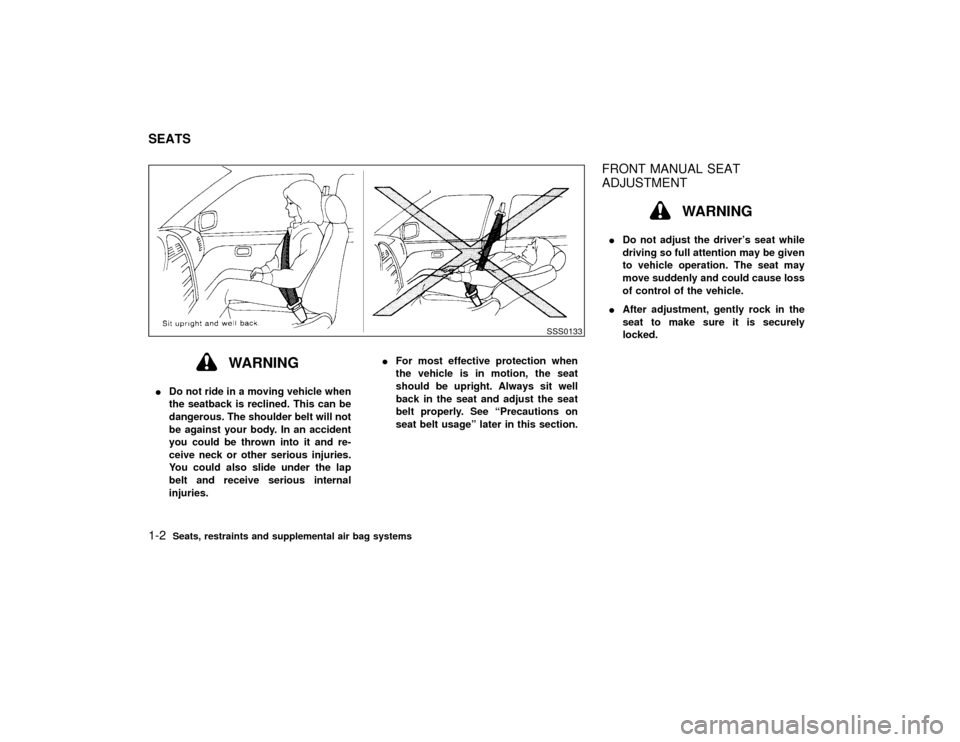
WARNING
IDo not ride in a moving vehicle when
the seatback is reclined. This can be
dangerous. The shoulder belt will not
be against your body. In an accident
you could be thrown into it and re-
ceive neck or other serious injuries.
You could also slide under the lap
belt and receive serious internal
injuries.IFor most effective protection when
the vehicle is in motion, the seat
should be upright. Always sit well
back in the seat and adjust the seat
belt properly. See ªPrecautions on
seat belt usageº later in this section.
FRONT MANUAL SEAT
ADJUSTMENT
WARNING
IDo not adjust the driver's seat while
driving so full attention may be given
to vehicle operation. The seat may
move suddenly and could cause loss
of control of the vehicle.
IAfter adjustment, gently rock in the
seat to make sure it is securely
locked.
SSS0133
SEATS1-2
Seats, restraints and supplemental air bag systems
Z
00.1.17/A33-D/V5.0
X
Page 8 of 247
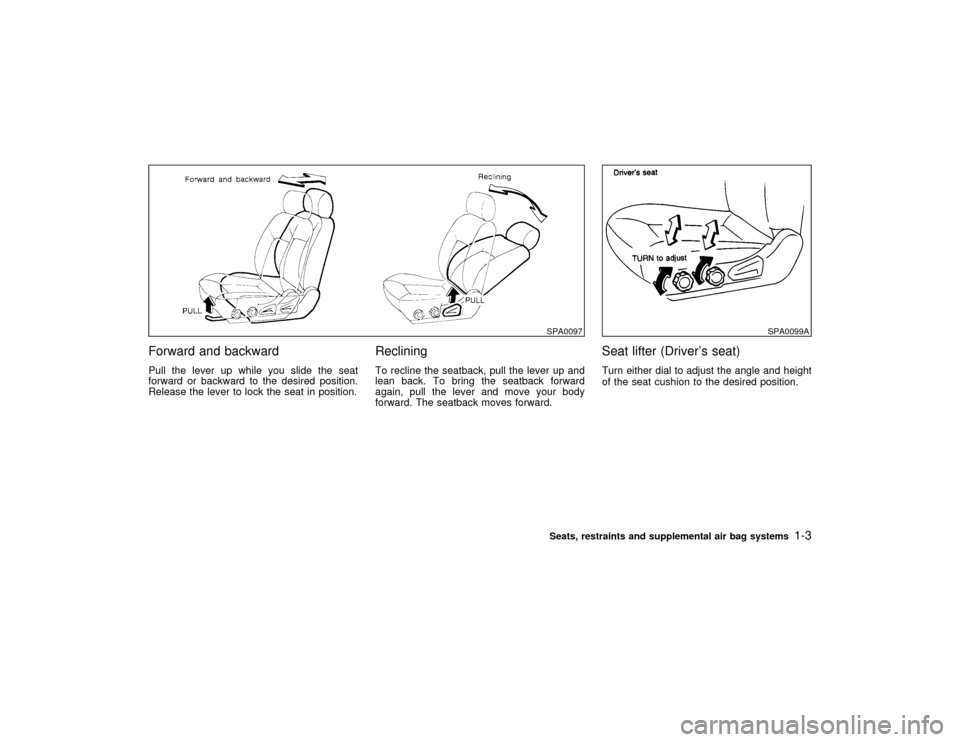
Forward and backwardPull the lever up while you slide the seat
forward or backward to the desired position.
Release the lever to lock the seat in position.
RecliningTo recline the seatback, pull the lever up and
lean back. To bring the seatback forward
again, pull the lever and move your body
forward. The seatback moves forward.
Seat lifter (Driver's seat)Turn either dial to adjust the angle and height
of the seat cushion to the desired position.
SPA0097
SPA0099A
Seats, restraints and supplemental air bag systems
1-3
Z
00.1.17/A33-D/V5.0
X
Page 11 of 247
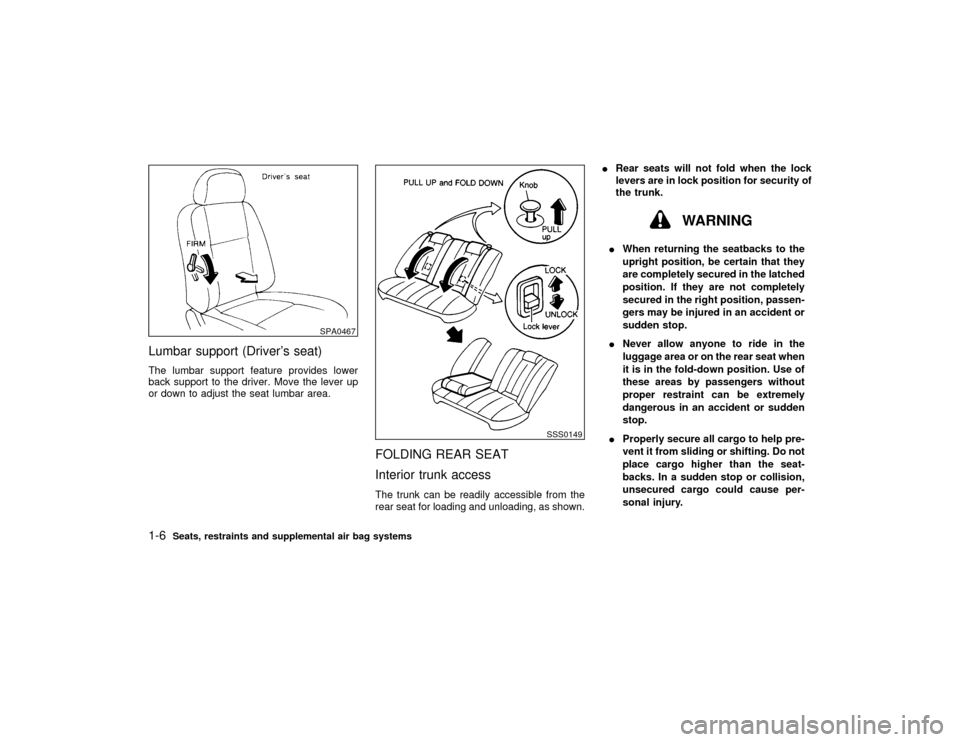
Lumbar support (Driver's seat)The lumbar support feature provides lower
back support to the driver. Move the lever up
or down to adjust the seat lumbar area.
FOLDING REAR SEAT
Interior trunk accessThe trunk can be readily accessible from the
rear seat for loading and unloading, as shown.IRear seats will not fold when the lock
levers are in lock position for security of
the trunk.
WARNING
IWhen returning the seatbacks to the
upright position, be certain that they
are completely secured in the latched
position. If they are not completely
secured in the right position, passen-
gers may be injured in an accident or
sudden stop.
INever allow anyone to ride in the
luggage area or on the rear seat when
it is in the fold-down position. Use of
these areas by passengers without
proper restraint can be extremely
dangerous in an accident or sudden
stop.
IProperly secure all cargo to help pre-
vent it from sliding or shifting. Do not
place cargo higher than the seat-
backs. In a sudden stop or collision,
unsecured cargo could cause per-
sonal injury.
SPA0467
SSS0149
1-6
Seats, restraints and supplemental air bag systems
Z
00.1.17/A33-D/V5.0
X
Page 12 of 247
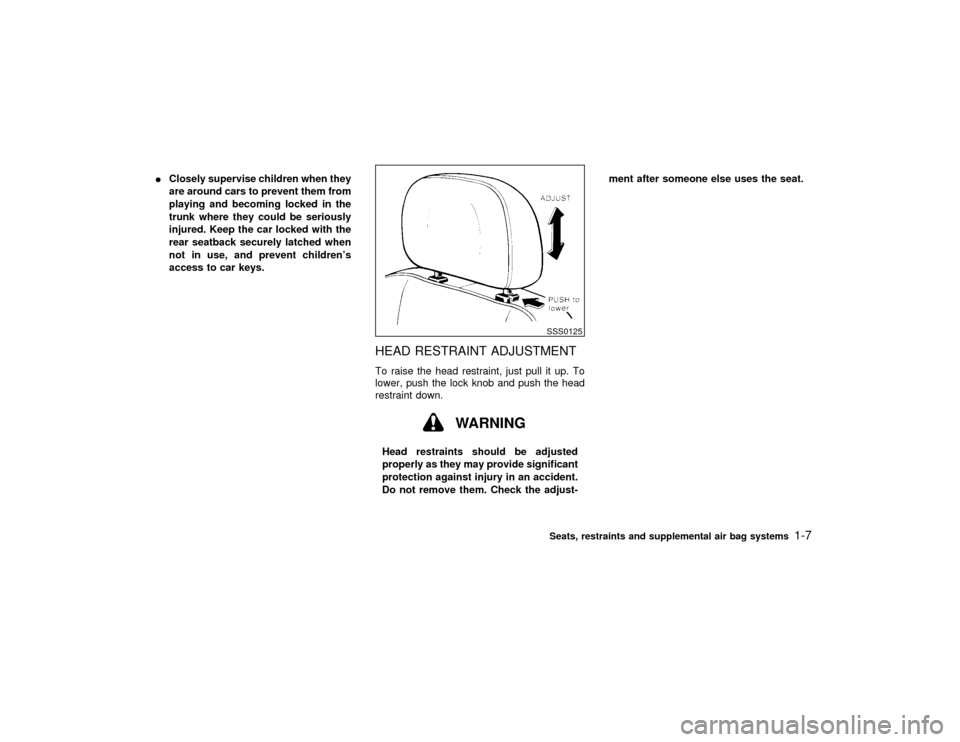
IClosely supervise children when they
are around cars to prevent them from
playing and becoming locked in the
trunk where they could be seriously
injured. Keep the car locked with the
rear seatback securely latched when
not in use, and prevent children's
access to car keys.
HEAD RESTRAINT ADJUSTMENTTo raise the head restraint, just pull it up. To
lower, push the lock knob and push the head
restraint down.
WARNING
Head restraints should be adjusted
properly as they may provide significant
protection against injury in an accident.
Do not remove them. Check the adjust-ment after someone else uses the seat.
SSS0125Seats, restraints and supplemental air bag systems
1-7
Z
00.1.17/A33-D/V5.0
X
Page 25 of 247

light will turn off after about 7 seconds if the
system is operational.
If any of the following conditions occur, the
supplemental front air bag system, supple-
mental side air bag system, and pre-tensioner
seat belt need servicing:
IThe supplemental air bag warning light
remains on after approximately 7 seconds.
IThe supplemental air bag warning light
flashes intermittently.
IThe supplemental air bag warning light
does not come on at all.
Under these conditions, the supplemental front
air bags, supplemental side air bags and/or
pre-tensioner seat belt may not operate prop-
erly. They must be checked and repaired.
Take your vehicle to the nearest authorized
NISSAN dealer.
WARNING
If the supplemental air bag warning light
is on, it could mean that the supplemen-
tal front air bag system, supplemental
side air bag system and/or pre-tensioner
seat belt will not operate in an accident.
Repair and replacement procedureThe supplemental front air bags, supplemental
side air bags and pre-tensioner seat belt are
designed to inflate on a one-time-only basis.
As a reminder, unless it is damaged, the
supplemental air bag warning light will remain
illuminated after inflation has occurred. Repair
and replacement of these systems should be
done only by authorized NISSAN dealers.
To ensure long-term functioning, these
systems must be inspected 10 years after
the date of manufacture noted on the cer-
tification label located on the driver side
center pillar.
When maintenance work is required on the
vehicle, the supplemental front air bags,
supplemental side air bags, related parts and
pre-tensioner seat belt should be pointed out
to the person conducting the maintenance.
The ignition key should always be in the LOCK
position when working under the hood or in-
side the vehicle.
WARNING
IOnce the supplemental front air bag,
supplemental side air bag and/or pre-tensioner seat belt has in flated, the
air bag module will not function again
and must be replaced. The module
should be replaced by an authorized
NISSAN dealer. The supplemental
front air bag module or supplemental
side air bag module cannot be re-
paired.
IThe supplemental front air bag sys-
tem, supplemental side air bag sys-
tem and pre-tensioner seat belt
should be inspected by an authorized
NISSAN dealer if there is any damage
to the front end or side portion of the
vehicle.
IIf you need to dispose of these
supplemental systems or scrap the
vehicle, contact an authorized
NISSAN dealer.
Correct disposal procedures are set
forth in the appropriate NISSAN Ser-
vice Manual. Incorrect disposal pro-
cedures could cause personal injury.
1-20
Seats, restraints and supplemental air bag systems
Z
00.1.17/A33-D/V5.0
X
Page 30 of 247
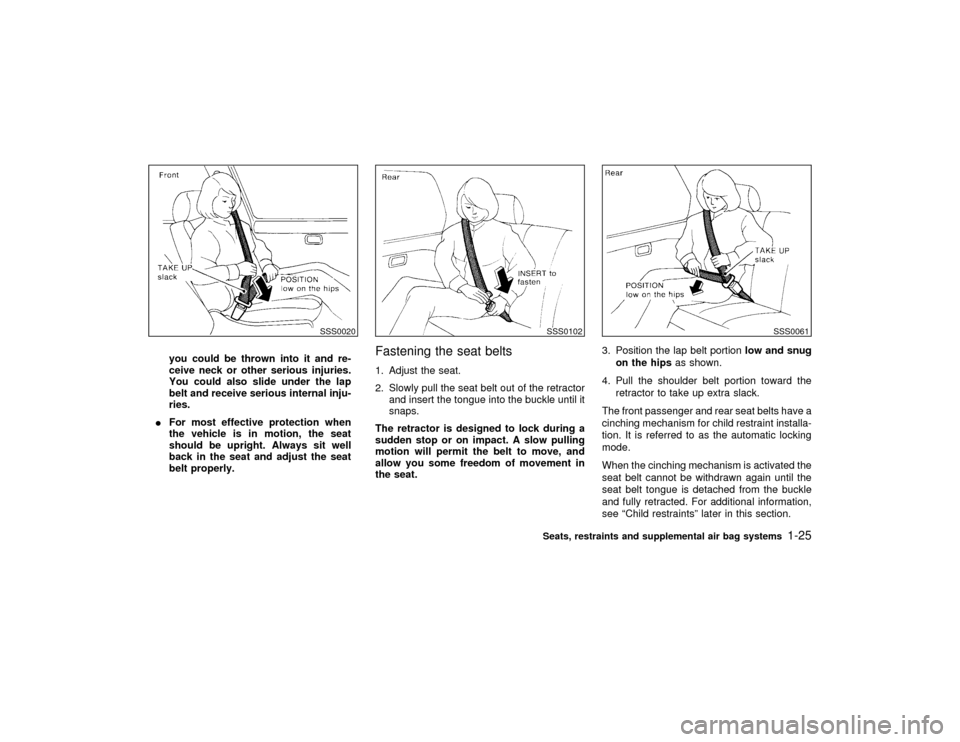
you could be thrown into it and re-
ceive neck or other serious injuries.
You could also slide under the lap
belt and receive serious internal inju-
ries.
IFor most effective protection when
the vehicle is in motion, the seat
should be upright. Always sit well
back in the seat and adjust the seat
belt properly.
Fastening the seat belts1. Adjust the seat.
2. Slowly pull the seat belt out of the retractor
and insert the tongue into the buckle until it
snaps.
The retractor is designed to lock during a
sudden stop or on impact. A slow pulling
motion will permit the belt to move, and
allow you some freedom of movement in
the seat.3. Position the lap belt portionlow and snug
on the hipsas shown.
4. Pull the shoulder belt portion toward the
retractor to take up extra slack.
The front passenger and rear seat belts have a
cinching mechanism for child restraint installa-
tion. It is referred to as the automatic locking
mode.
When the cinching mechanism is activated the
seat belt cannot be withdrawn again until the
seat belt tongue is detached from the buckle
and fully retracted. For additional information,
see ªChild restraintsº later in this section.
SSS0020
SSS0102
SSS0061
Seats, restraints and supplemental air bag systems
1-25
Z
00.1.17/A33-D/V5.0
X
Page 31 of 247
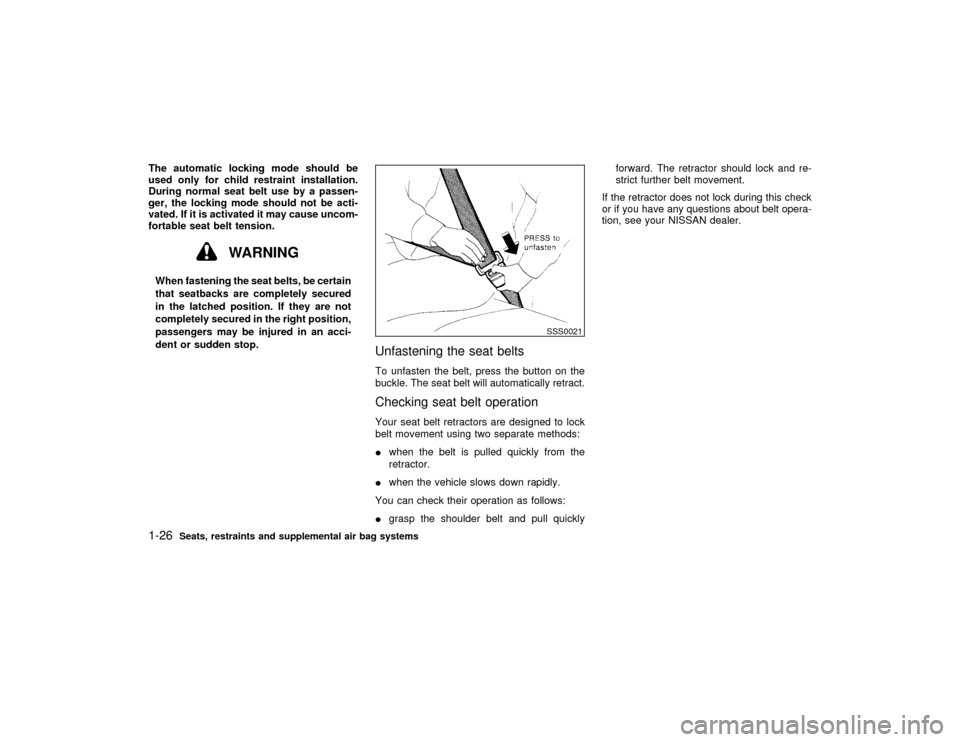
The automatic locking mode should be
used only for child restraint installation.
During normal seat belt use by a passen-
ger, the locking mode should not be acti-
vated. If it is activated it may cause uncom-
fortable seat belt tension.
WARNING
When fastening the seat belts, be certain
that seatbacks are completely secured
in the latched position. If they are not
completely secured in the right position,
passengers may be injured in an acci-
dent or sudden stop.
Unfastening the seat beltsTo unfasten the belt, press the button on the
buckle. The seat belt will automatically retract.Checking seat belt operationYour seat belt retractors are designed to lock
belt movement using two separate methods:
Iwhen the belt is pulled quickly from the
retractor.
Iwhen the vehicle slows down rapidly.
You can check their operation as follows:
Igrasp the shoulder belt and pull quicklyforward. The retractor should lock and re-
strict further belt movement.
If the retractor does not lock during this check
or if you have any questions about belt opera-
tion, see your NISSAN dealer.
SSS0021
1-26
Seats, restraints and supplemental air bag systems
Z
00.1.17/A33-D/V5.0
X
Page 32 of 247
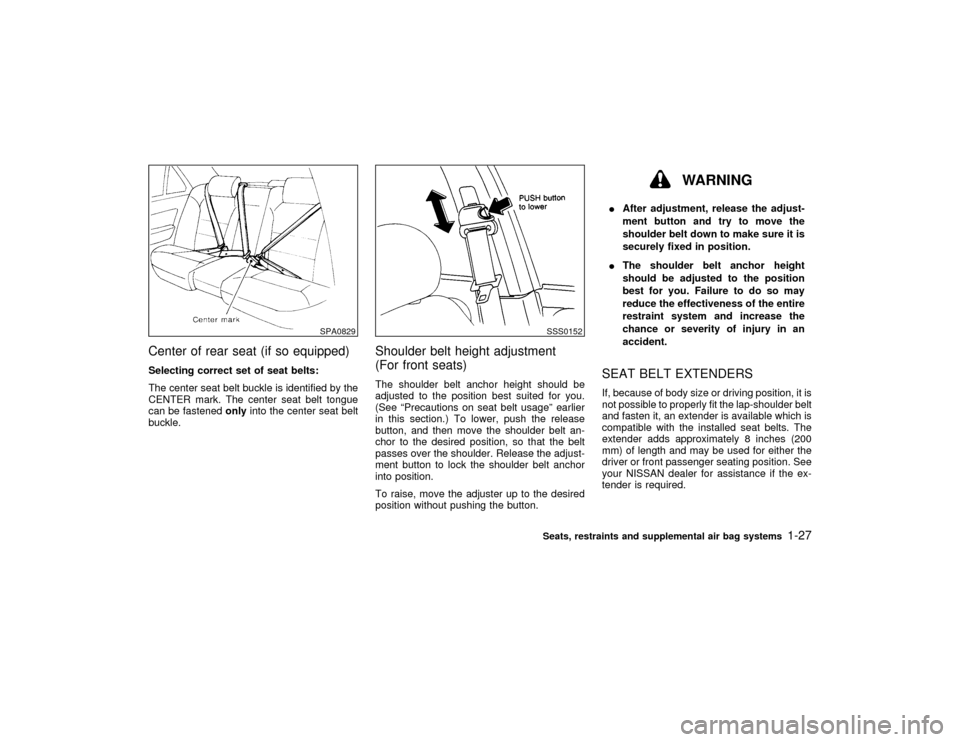
Center of rear seat (if so equipped)Selecting correct set of seat belts:
The center seat belt buckle is identified by the
CENTER mark. The center seat belt tongue
can be fastenedonlyinto the center seat belt
buckle.
Shoulder belt height adjustment
(For front seats)The shoulder belt anchor height should be
adjusted to the position best suited for you.
(See ªPrecautions on seat belt usageº earlier
in this section.) To lower, push the release
button, and then move the shoulder belt an-
chor to the desired position, so that the belt
passes over the shoulder. Release the adjust-
ment button to lock the shoulder belt anchor
into position.
To raise, move the adjuster up to the desired
position without pushing the button.
WARNING
IAfter adjustment, release the adjust-
ment button and try to move the
shoulder belt down to make sure it is
securely fixed in position.
IThe shoulder belt anchor height
should be adjusted to the position
best for you. Failure to do so may
reduce the effectiveness of the entire
restraint system and increase the
chance or severity of injury in an
accident.SEAT BELT EXTENDERSIf, because of body size or driving position, it is
not possible to properly fit the lap-shoulder belt
and fasten it, an extender is available which is
compatible with the installed seat belts. The
extender adds approximately 8 inches (200
mm) of length and may be used for either the
driver or front passenger seating position. See
your NISSAN dealer for assistance if the ex-
tender is required.
SPA0829
SSS0152Seats, restraints and supplemental air bag systems
1-27
Z
00.1.17/A33-D/V5.0
X